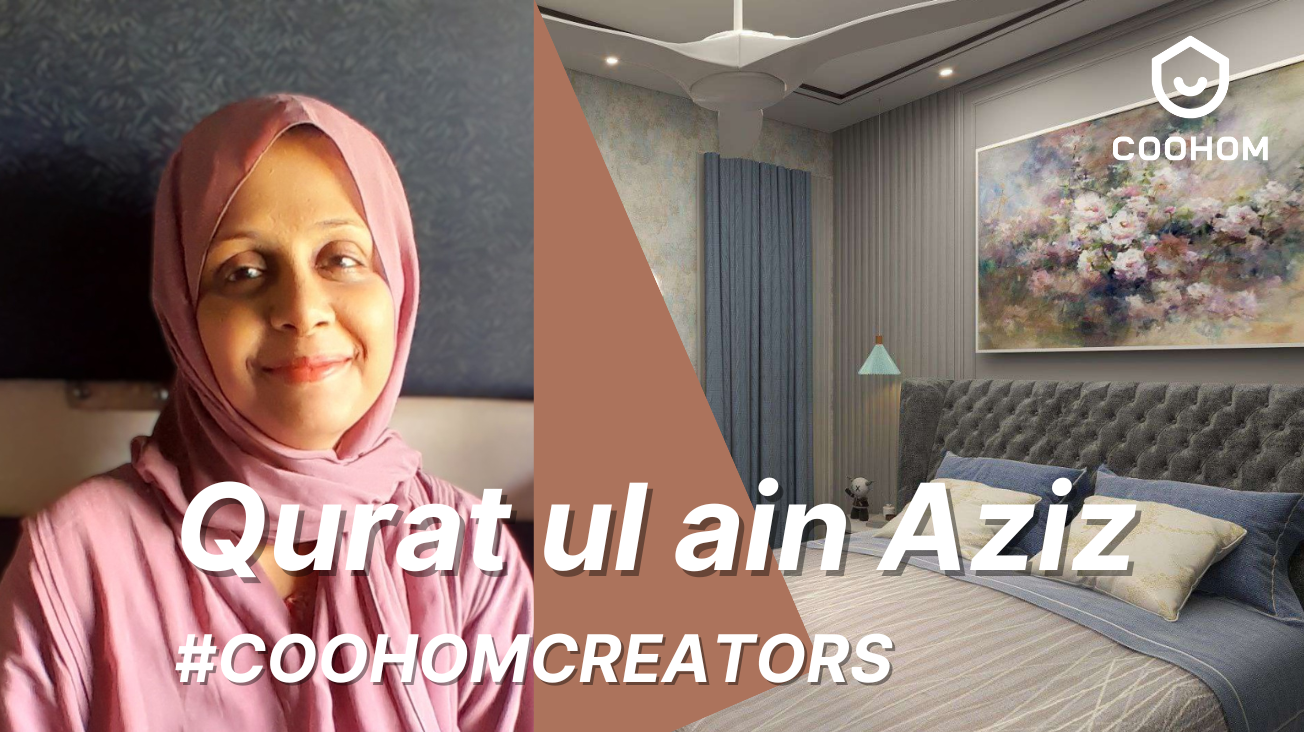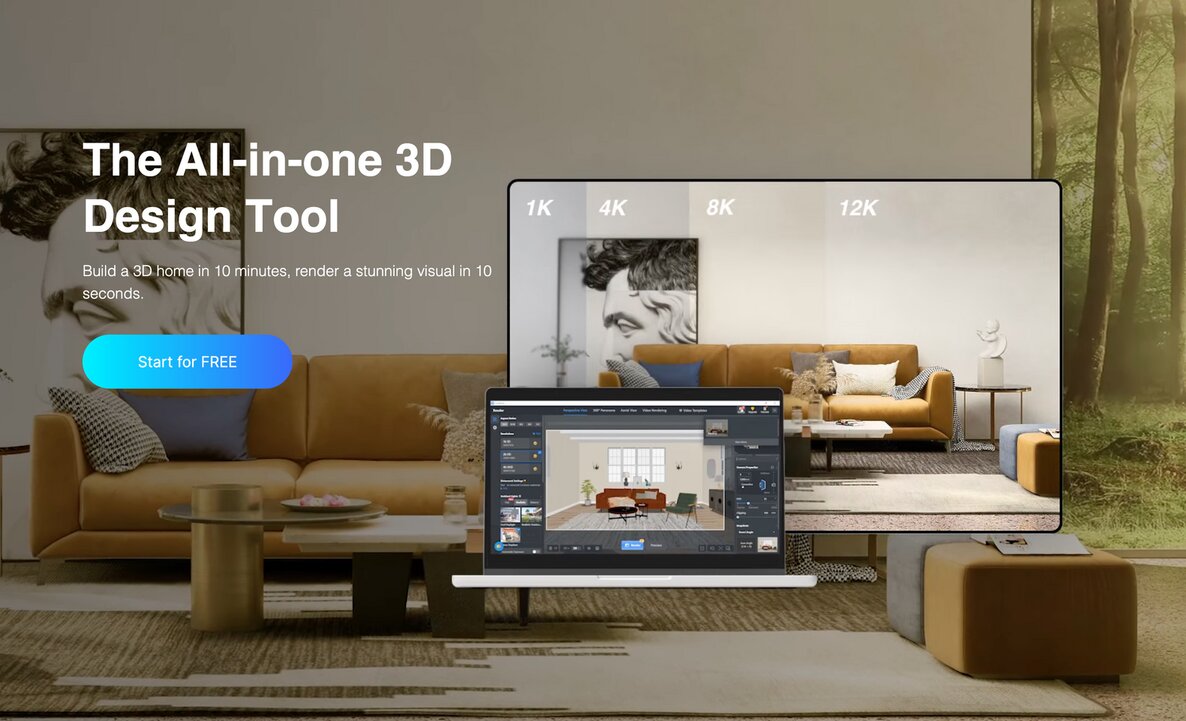According to Pakistan Gender Pay Gap Report 2025, women constitute only 13.5 percent of employees in Pakistan. This is a story about one of those 13.5%: Ms. Qurat ul ain Aziz.
Qurat ul ain is a Pakistani 3D interior design artist and color consultant passionate about transforming spaces with a blend of Minimalism and Biophilic design. As the founder of Uslub, a women-led e-interior design startup in Pakistan, she focuses on sustainable, high-end solutions that bring harmony to homes and commercial spaces.
Qurat ul ain believes that “every space tells a story”. Two years ago, she knew Coohom from an interior design training course and was amazed by the software that was completely new to her back then. She started to watch teaching videos on Coohom’s YouTube channel every day, and now Coohom has become the media to convey her thoughts and feelings through all spaces she designs.
Coohom Makes Design and Life Easier
For Qurat ul ain, design is more than decoration. “It’s also problem-solving. It should make your life easier.” Among all projects she has completed using Coohom, her favorite one is a sensory room she designed for an autistic teenager.
In Pakistan, most people are not available for designing a sensory room. Qurat ul ain, however, decided to take the challenge with the help of Coohom. She used Coohom for designing, material selection, rendering, and making videos, which made it super easy for her to show the client what exactly the room would look like and what the client would need to build the room. It took her only 15 days to finish designing the room, and within another two weeks, the teen finally owned a sensory room.
According to Qurat ul ain, creating a sensory-friendly bedroom isn’t just about aesthetics. It’s about building a space that feels safe, empowering, and emotionally attuned to the child’s needs. Every detail of the room was chosen with purpose. The galaxy-themed ceiling offers visual calm and sparks imagination; checkered carpet tiles provide soft, structured flooring for movement and play; climbing walls, swings, and foam tunnels encourage physical engagement and sensory regulation; interactive light panels, cozy seating, and playful murals create zones for learning, relaxation, and emotional comfort; and open shelving and visual clarity promote independence and reduce overwhelm. “This room is more than functional—it’s a sanctuary where the child can explore, decompress, and thrive.”
This project is a testament to how Qurat ul ain interprets the meaning of design as well as a perfect example of how Coohom makes design easier and tackles real-life difficulties. “Her mother was extremely happy. She said (to me that) you made my life easier. That’s my favorite project because I solved the problem for a client.”
Coohom Brings a Work-life Balance
One thing that Qurat ul ain likes the most about Coohom is that it is a cloud-based software. It saves much space for her laptop; it allows her to expand her business and collaborate remotely with international clients outside of Pakistan; it also benefits her in that she can work in her home office. The last point is more than attractive to Qurat ul ain, who is a talented interior designer, an entrepreneur, plus a mother of two young children. With Coohom, she can well manage her projects while taking care of her family.
Her work and life are integrated in an amazing and surprising way. “I involve my family, especially my daughter, in all my designs. (My daughter) has a very good sense of color and can actually help me design. Whenever I make any design, I always get feedback from my son and my daughter. Sometimes, I change the lighting, the selection of some furniture items, or something else, after the feedback. It’s a very good experience. It’s fun.”
Besides, Coohom as a relatively cheap software provides more women with affordable sources to learn design in Pakistan, where most design training are limited and less accessible to women in general.
An Upholder of Sustainability
“Sustainability and sticking to natural material and natural life are my philosophy”, said Qurat ul ain. She has integrated sustainability to each of her project and each step of her design. She recommends her clients to choose the style of Minimalism; for material and furniture selection, she encourages them to pick those that are good for the environment.
Qurat ul ain also stressed the importance of visualization, one of its features that Coohom is proud of. She always makes videos in Coohom and shows them to her clients before they actually go out and buy a bunch of furniture. “Coohom provides the opportunity to just lay out the materials before purchasing. It prevents unnecessary buying or major mistakes.”
A Feeling of Belongingness
Qurat ul ain mentions Coohom EVERYWHERE. “Everyone knows me knows about Coohom”, she joked. Being easy-to-use, time-saving, cloud-based, and affordable, Coohom distinguishes itself from all other software that Qurat ul ain has used in the past. “When I design something and show videos to my friends and families, they would say, wow, that’s what you live on.”
Recently, Qurat ul ain has been trying to introduce more people in her workshops to the design software that greatly assists her in her career. So far, she has organized three workshops, two online and one offline, attracting dozens of people each time. The courses target household women and students majoring in architecture and interior design and cover topics including sustainability, choosing the right colors, and how to plan a space or select furniture. All her teaching materials are created in Coohom.
“Coohom gives me the feeling of belongingness.” Now, Qurat ul ain is ready to organize a workshop every month and spread this amazing feeling to a larger audience. Her stories speak loudly that Coohom is much more than a friendly design software. It truly helps to solve real-life problems, recognize the value of women’s careers, and promote sustainable development.

